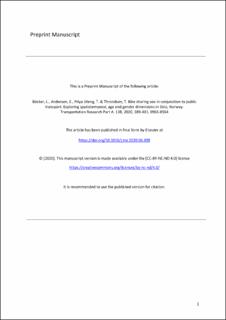| dc.contributor.author | Böcker, Lars | |
| dc.contributor.author | Anderson, Ellinor Ragnhild | |
| dc.contributor.author | Priya Uteng, Tanu | |
| dc.contributor.author | Throndsen, Torstein S. | |
| dc.coverage.spatial | Oslo, Norway | en_US |
| dc.date.accessioned | 2021-07-28T11:34:48Z | |
| dc.date.available | 2021-07-28T11:34:48Z | |
| dc.date.created | 2020-07-20T15:03:42Z | |
| dc.date.issued | 2020-06-27 | |
| dc.identifier.citation | Transportation Research Part A: Policy and Practice. 2020, 138 (August 2020), 389-401. | en_US |
| dc.identifier.issn | 0965-8564 | |
| dc.identifier.uri | https://hdl.handle.net/11250/2765524 | |
| dc.description.abstract | Bike sharing could provide a key role in a transition towards a less car dependent and more sustainable, healthy and socially inclusive urban transport future. This paper investigates two important prerequisites for bike sharing to fulfil these premises: Does it synergise rather than compete with current alternatives to car-based urban mobility; and is it inclusively accessible across population and spatial segments? Drawing on complete 2016–2017 trip records of the Oslo (Norway) bike sharing system, this paper analyses the potential use of bike sharing for accessing, egressing and interchanging public transport and explores its age and gender dimensions. Bike sharing ridership is substantially higher on routes that either start or end with metro/rail connectivity, whilst controlling for other factors, such as route distance, elevation, urban form, time of day and bike dock capacities. However, our results also reveal that bike sharing – both as a stand-alone system and in conjunction with public transport – is less accessible to, suited to, and used by women and older age groups. Especially gender biases appear profound, multifaceted, and intersected by spatial inequalities favouring central male-dominated employment areas. These findings are discussed to derive policy and design directions regarding multimodal integration, dock expansion, rental limitations, and the introduction of e-bikes, to improve the performance, multimodal integration, gender equality and overall socio-spatial inclusiveness of bike sharing. | en_US |
| dc.language.iso | eng | en_US |
| dc.publisher | Elsevier | en_US |
| dc.rights | Attribution-NonCommercial-NoDerivatives 4.0 Internasjonal | * |
| dc.rights | Attribution-NonCommercial-NoDerivatives 4.0 Internasjonal | * |
| dc.rights.uri | http://creativecommons.org/licenses/by-nc-nd/4.0/deed.no | * |
| dc.title | Bike sharing use in conjunction to public transport: Exploring spatiotemporal, age and gender dimensions in Oslo, Norway | en_US |
| dc.type | Peer reviewed | en_US |
| dc.type | Journal article | en_US |
| dc.rights.holder | © 2020 Published by Elsevier Ltd. | en_US |
| dc.description.version | submittedVersion | en_US |
| cristin.ispublished | true | |
| cristin.fulltext | preprint | |
| cristin.qualitycode | 2 | |
| dc.identifier.doi | 10.1016/j.tra.2020.06.009 | |
| dc.identifier.cristin | 1819891 | |
| dc.source.journal | Transportation Research Part A: Policy and Practice | en_US |
| dc.source.volume | 138 | en_US |
| dc.source.issue | August 2020 | en_US |
| dc.source.pagenumber | 389-401 | en_US |
| dc.relation.project | Norges forskningsråd: 267877 | en_US |
| dc.relation.project | Norges forskningsråd: 295704 | en_US |

